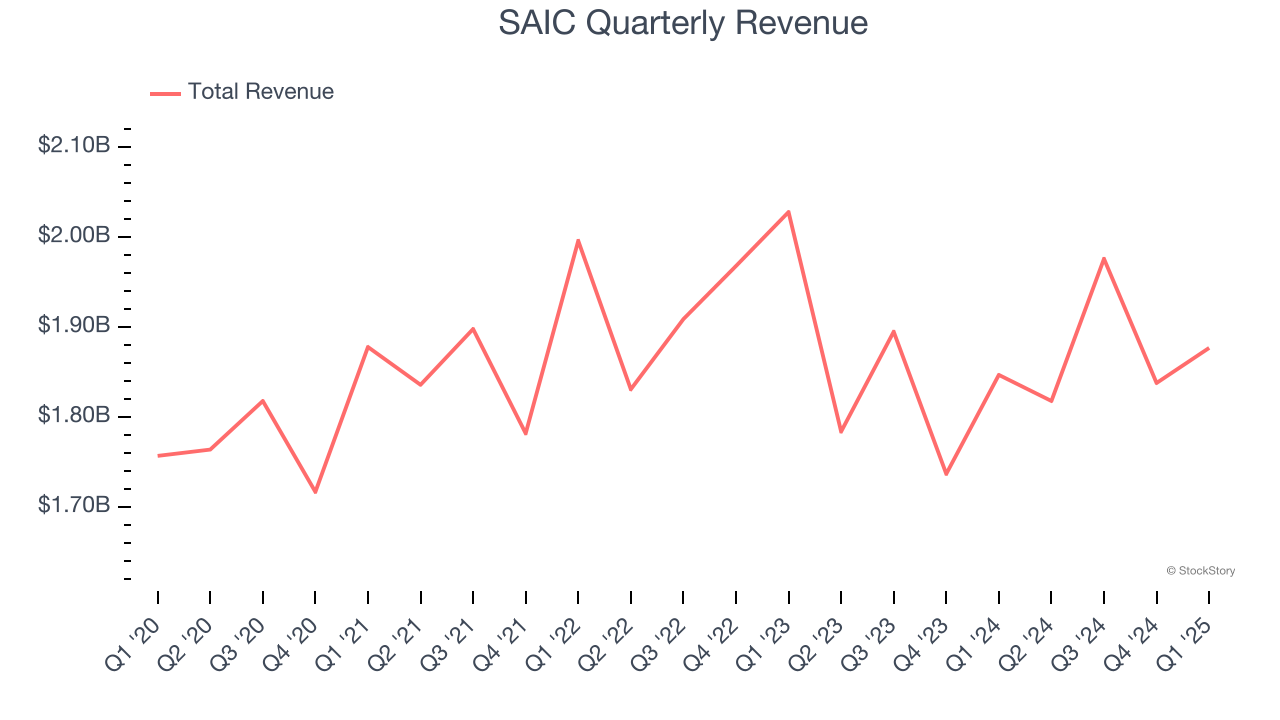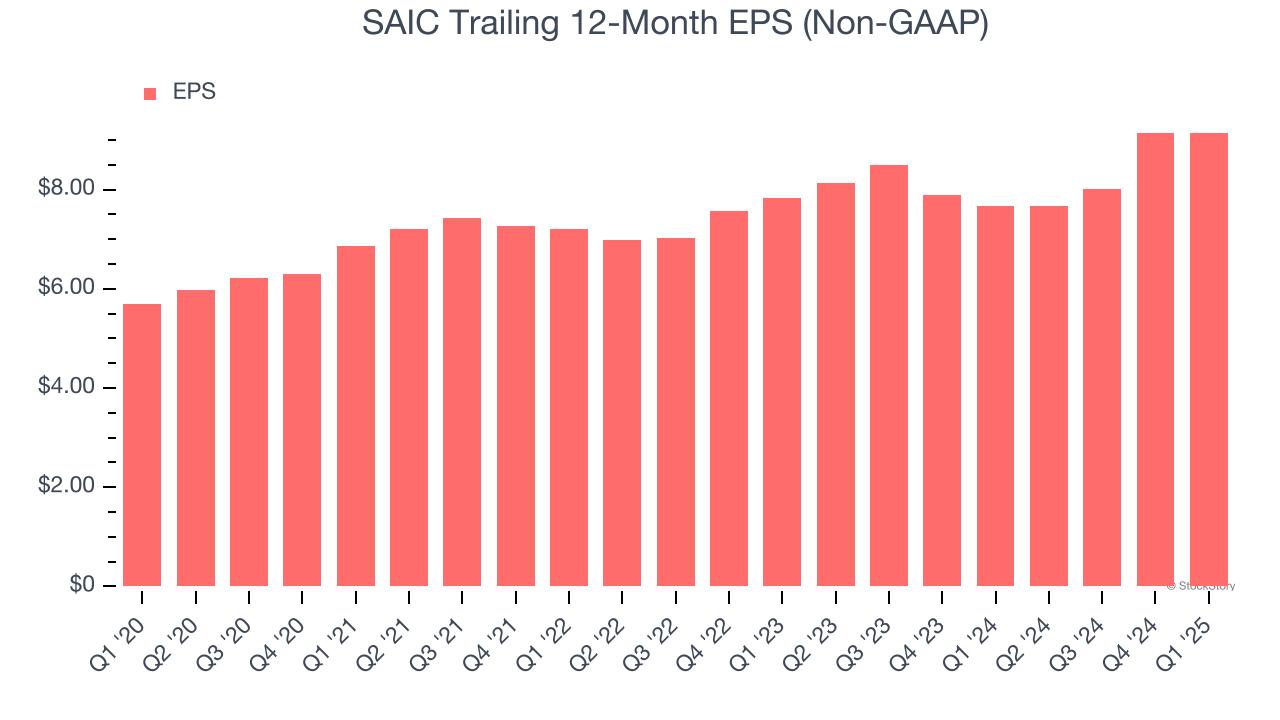
Government IT services provider Science Applications International Corporation (NASDAQ:SAIC) reported Q1 CY2025 results exceeding the market’s revenue expectations, with sales up 1.6% year on year to $1.88 billion. The company expects the full year’s revenue to be around $7.68 billion, close to analysts’ estimates. Its non-GAAP profit of $1.92 per share was 9.3% below analysts’ consensus estimates.
Is now the time to buy SAIC? Find out by accessing our full research report, it’s free.
SAIC (SAIC) Q1 CY2025 Highlights:
- Revenue: $1.88 billion vs analyst estimates of $1.87 billion (1.6% year-on-year growth, 0.6% beat)
- Adjusted EPS: $1.92 vs analyst expectations of $2.12 (9.3% miss)
- Adjusted EBITDA: $157 million vs analyst estimates of $172.2 million (8.4% margin, 8.8% miss)
- The company reconfirmed its revenue guidance for the full year of $7.68 billion at the midpoint
- Management reiterated its full-year Adjusted EPS guidance of $9.20 at the midpoint
- EBITDA guidance for the full year is $725 million at the midpoint, below analyst estimates of $729.2 million
- Operating Margin: 6.4%, in line with the same quarter last year
- Free Cash Flow was -$44 million, down from $21 million in the same quarter last year
- Backlog: $22.34 billion at quarter end
- Market Capitalization: $5.45 billion
Company Overview
With over five decades of experience supporting national security missions, Science Applications International Corporation (NASDAQ:SAIC) provides technical, engineering, and enterprise IT services primarily to U.S. government agencies and military branches.
Sales Growth
A company’s long-term performance is an indicator of its overall quality. Any business can have short-term success, but a top-tier one grows for years.
With $7.51 billion in revenue over the past 12 months, SAIC is one of the larger companies in the business services industry and benefits from a well-known brand that influences purchasing decisions. However, its scale is a double-edged sword because it’s harder to find incremental growth when you’ve penetrated most of the market. For SAIC to boost its sales, it likely needs to adjust its prices, launch new offerings, or lean into foreign markets.
As you can see below, SAIC’s sales grew at a sluggish 2.9% compounded annual growth rate over the last five years. This shows it failed to generate demand in any major way and is a rough starting point for our analysis.

We at StockStory place the most emphasis on long-term growth, but within business services, a half-decade historical view may miss recent innovations or disruptive industry trends. SAIC’s performance shows it grew in the past but relinquished its gains over the last two years, as its revenue fell by 1.5% annually. 
This quarter, SAIC reported modest year-on-year revenue growth of 1.6% but beat Wall Street’s estimates by 0.6%.
Looking ahead, sell-side analysts expect revenue to grow 3.1% over the next 12 months. While this projection indicates its newer products and services will catalyze better top-line performance, it is still below the sector average.
Today’s young investors won’t have read the timeless lessons in Gorilla Game: Picking Winners In High Technology because it was written more than 20 years ago when Microsoft and Apple were first establishing their supremacy. But if we apply the same principles, then enterprise software stocks leveraging their own generative AI capabilities may well be the Gorillas of the future. So, in that spirit, we are excited to present our Special Free Report on a profitable, fast-growing enterprise software stock that is already riding the automation wave and looking to catch the generative AI next.
Operating Margin
Operating margin is a key measure of profitability. Think of it as net income - the bottom line - excluding the impact of taxes and interest on debt, which are less connected to business fundamentals.
SAIC was profitable over the last five years but held back by its large cost base. Its average operating margin of 7.3% was weak for a business services business.
On the plus side, SAIC’s operating margin rose by 1.2 percentage points over the last five years, as its sales growth gave it operating leverage.

In Q1, SAIC generated an operating margin profit margin of 6.4%, in line with the same quarter last year. This indicates the company’s overall cost structure has been relatively stable.
Earnings Per Share
We track the long-term change in earnings per share (EPS) for the same reason as long-term revenue growth. Compared to revenue, however, EPS highlights whether a company’s growth is profitable.
SAIC’s EPS grew at a solid 9.9% compounded annual growth rate over the last five years, higher than its 2.9% annualized revenue growth. This tells us the company became more profitable on a per-share basis as it expanded.

Diving into SAIC’s quality of earnings can give us a better understanding of its performance. As we mentioned earlier, SAIC’s operating margin was flat this quarter but expanded by 1.2 percentage points over the last five years. On top of that, its share count shrank by 18.3%. These are positive signs for shareholders because improving profitability and share buybacks turbocharge EPS growth relative to revenue growth. 
In Q1, SAIC reported EPS at $1.92, in line with the same quarter last year. This print missed analysts’ estimates, but we care more about long-term EPS growth than short-term movements. Over the next 12 months, Wall Street expects SAIC’s full-year EPS of $9.15 to grow 4.7%.
Key Takeaways from SAIC’s Q1 Results
It was good to see SAIC narrowly top analysts’ revenue expectations this quarter. On the other hand, its EPS missed and its full-year EPS guidance fell slightly short of Wall Street’s estimates. Overall, this was a weaker quarter. The stock traded down 6.3% to $108.26 immediately following the results.
SAIC’s latest earnings report disappointed. One quarter doesn’t define a company’s quality, so let’s explore whether the stock is a buy at the current price. The latest quarter does matter, but not nearly as much as longer-term fundamentals and valuation, when deciding if the stock is a buy. We cover that in our actionable full research report which you can read here, it’s free.
